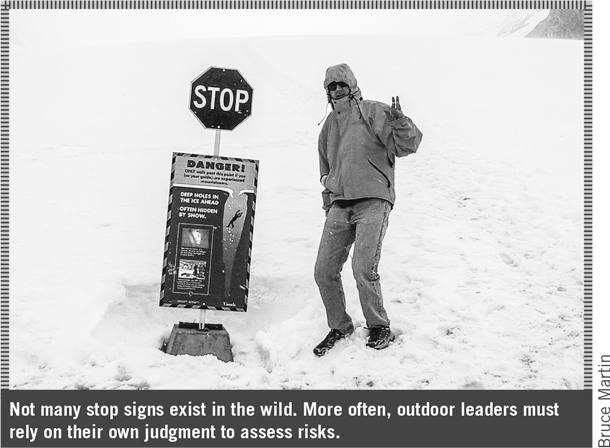Decision Making and Judgment in Risk Management
This is an excerpt from Outdoor Leadership 3rd Edition With HKPropel Access by Bruce Martin,Mary Breunig,Mark Wagstaff,Marni Goldenberg.
Paul Petzoldt is noted for his many maxims that speak to the realities outdoor leaders face daily. One of these addresses the role of decision making and judgment in safety and risk management: “Rules are for fools!” There are two general approaches to decision making in the outdoors: one based on rules and one based on judgment. A leader who relies solely on a rules-based approach to decision making refers solely to the instructor field manual, the program policies and procedures manual, and other guidelines for insight on how to approach problematic situations. Petzoldt’s point is that no set of rules can address every problem a leader might encounter. Although rules and guidelines are useful, they should represent only one part of a more comprehensive approach to safety and risk management. Those who rely solely on rules or guidelines as a basis for decision making will eventually find themselves in a situation for which they are ill prepared and for which the guidelines come up short. Rather than a strictly prescriptive, rules-based approach to decision making, Petzoldt advocates for a judgment-based approach as an integral component of effective outdoor leadership.
The difference between the two approaches can be illustrated by the experience of a rock climbing instructor trained to manage a particular climbing site. The program uses the same site for all of its climbing programs, and it trains its instructors specifically for this site. The instructor is familiar with all climbing routes, anchor points, setups, and safety concerns at the site. However, it is the only site at which they have worked, and they are unfamiliar with many general principles of rock climbing. Imagine asking this instructor to lead a group of students in climbing at an unfamiliar site where they must identify all climbing routes, anchor points, and safety concerns. Because of this program’s prescriptive approach to training, its leaders are not equipped to ensure the safety of participants in areas with which they are unfamiliar. They have not been given the tools—the experience and knowledge—to exercise good judgment regarding the safety of their participants in unfamiliar settings.
Although program policies, procedures, and guidelines are integral to effective program management and, consequently, effective risk management, the importance of instructor judgment should not be overlooked. Judgment is an informed opinion that is based on experience, and decision making is the process of choosing the best option from a collection of options. A leader with good judgment and extensive experience has a much greater chance of selecting the best option in a problematic situation than a leader who simply relies on preset rules or guidelines in approaching the problem. See chapter 7 for a fuller discussion of the nature of decision making and judgment and its importance to outdoor leadership.

SHOP

Get the latest insights with regular newsletters, plus periodic product information and special insider offers.
JOIN NOW
Latest Posts
- Sample mental health lesson plan of a skills-based approach
- Sample assessment worksheet for the skill of accessing valid and reliable resources
- Help your students overcome what holds them back from making health-promoting choices
- Example of an off-season microcycle
- Modifying lifts
- Screening for multilevel programs in a team environment


